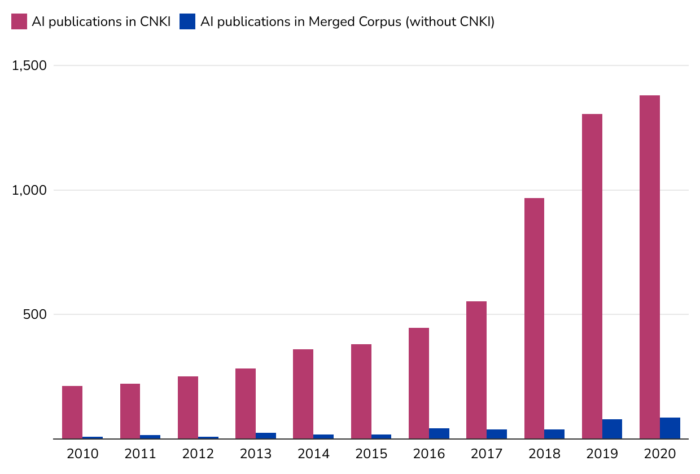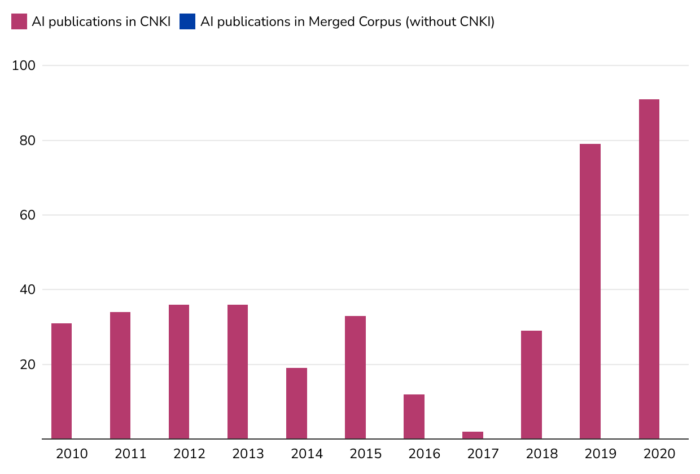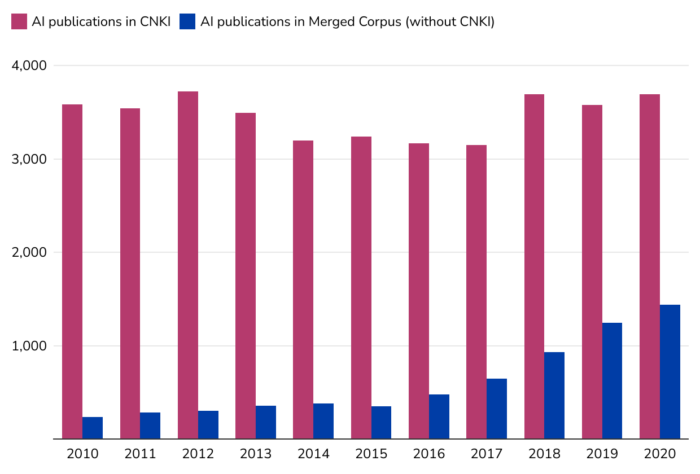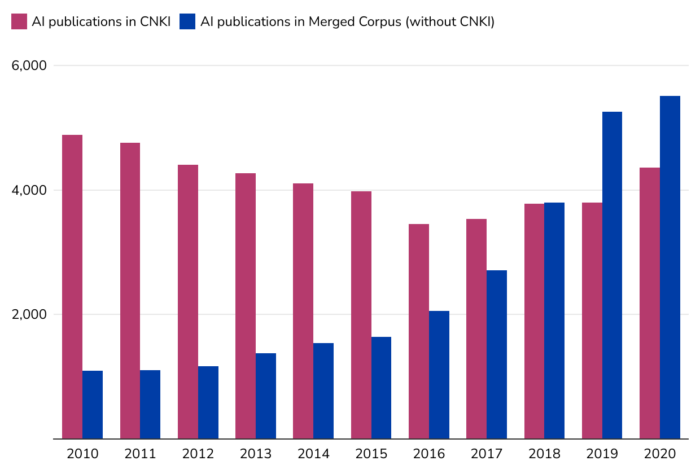Introduction
This analysis serves as a supplement to the March 2021 CSET data brief “The Public AI Research Portfolio of China’s Security Forces.” In that data brief, we analyzed artificial intelligence research output among components of China’s security forces and found that the overwhelming majority (93 percent) of published AI research authored by affiliates of China’s security force organizations was published in Chinese.
This supplement expands our look at public AI research affiliated with China’s security forces by exploring the output of other security-relevant actors in China. In writing the original data brief, we focused on certain lines of analysis to maintain a manageable scope. Here we retread our original path, and also explore new areas by examining public AI research portfolios of additional components of China’s security forces and affiliated universities.
We find trends reported in the original data brief still hold, specifically:
- China’s security forces published more AI research in Chinese language venues than in predominantly English language venues from 2010 through 2020.
- AI publications by authors affiliated with China’s security forces increased from 2010 through 2020, with output especially increasing since 2017.
We find trends among security-relevant actors to build on earlier findings. Specifically:
- China’s Ministry of Public Security published an increasing amount of AI research from 2010 to 2020, especially in Chinese language venues;
- Two People’s Liberation Army (PLA) components considered key drivers of AI development produced a low number of AI publications in this time period and published almost exclusively in Chinese language venues;
- PLA-administered universities published relatively more AI research over this time period, primarily in Chinese language venues. However, their number of AI publications in English language venues has also increased since 2017;
- China’s Seven Sons of National Defense maintained a high rate of AI publications since 2010, but as of 2018 published more AI research in predominantly English language venues than in Chinese language venues; and
- While Seven Sons universities are the most prolific publishing entities examined, AI research represents a smaller, though growing, share of their research output compared to the other entities analyzed here.
As in the original data brief, this analysis considers a publication to be “AI” if its title, abstract, or full text contains at least one match to a human-curated list of AI keywords.1 We use a keyword-based approach to identify AI research publications for consistency across languages.2 Publications resulting from an AI keyword search include not only fundamental AI research, but also applications of AI. An organization’s contribution to an AI publication is determined by the listed affiliation of publication authors. When at least one author lists affiliation with an organization, that publication is counted as one publication for that organization.3
Public AI research portfolios of components of China’s security forces
Here we break down some analysis of China’s security force AI research portfolios from the original data brief. First, we explore AI research output at the individual publication level for China’s Ministry of Public Security (公安部; MPS). Then we explore output among select “Miscellaneous” PLA components.
AI Research by China’s Ministry of Public Security
In recent years, reporting suggests an increased adoption of surveillance technologies by MPS, making the ministry an interesting component to explore in more detail. China’s security services are making greater use of AI, and it is having an increasingly large impact on their missions and operations. Surveillance technologies specifically have benefited from AI advances in application areas like computer vision, among others.
Figure 1 shows the number of AI publications with MPS affiliated authors in CNKI, or China National Knowledge Infrastructure (中国知网), a database of Chinese language publications. The figure also shows the number of such publications in CSET’s merged corpus of scholarly literature with all CNKI publications removed (this provides a database of primarily English-language publications).4 Having identified AI research as outlined above, we filter for publications with MPS affiliated-authors using bilingual variants of the following keywords: “公安部”, “Ministry of Public Security”, and “MPS”.5
Figure 1. China’s Ministry of Public Security AI Publications, 2010-2020

We see an upward trend in AI publications with MPS-affiliated authors from 2010 through 2020. Similar to the broader set of China’s security forces featured in our original data brief, MPS-affiliated authors published more AI research in Chinese language journals (aggregated by CNKI) than in the predominantly English language journals captured in CSET’s merged corpus with CNKI publications removed. Note that AI publications constitute 32 percent of all MPS-affiliated publications in 2020.
AI Research by “Miscellaneous” PLA Components
We also found in our original data brief that a large amount of AI research was affiliated with components we labeled as “PLA Miscellaneous Organizations.”6
This category referred to several PLA-affiliated entities outside of combatant command units, but included two PLA components that are considered to be key drivers of the PLA’s AI efforts:
- Strategic Support Force (战略支援部队; PLASSF); and
- Equipment Development Department (装备发展部; EDD), including EDD’s predecessor, the General Armaments Department (总装备部; GAD).7
The PLASSF’s mission is “supporting battlefield operations and ensuring local advantage in aerial, spatial, cyberspace, and electronic warfare…[PLASSF] is an important force in integrated warfare…[and the] key force to winning the war.”8 Meanwhile, EDD’s public activities involving AI include co-organizing the Integrated Warfare Intelligent War Games (联合作战智能博弈挑战赛).9 Various studies and news reports highlight the AI activities of these two PLA components, motivating a look into their public AI research output here.10
Figure 2 displays the number of AI publications affiliated with these PLA “AI key drivers” from 2010 through 2020 in CNKI and CSET’s merged corpus without CNKI. See Appendix A for the list of keywords used to filter for affiliated publications.
Figure 2. AI Publications of PLA “AI Key Driver” Components, 2010-2020

Public AI research output among these entities is low. This is especially notable compared to AI output from major research universities in China.11 It is possible that PLASSF and EDD personnel publish research under alternate affiliations or that classified research is not published in public venues.
Also, the public research coming out of these PLA components is published almost exclusively in CNKI journals. We did not identify any affiliated AI publications in CSET’s merged corpus without CNKI from 2010 through 2020. This is especially noteworthy given that AI publications make up approximately 24 percent of all research in CNKI with PLASSF and EDD-affiliated authors in 2020. The spike in publications following 2017 correlates with the timing of the Chinese government’s 2017 New Generation AI Development Plan (新一代人工智能发展规划).12
Public AI research portfolios of China’s security-affiliated universities
Here we expand the analysis presented in the original data brief by examining AI research output among various Chinese universities affiliated with China’s security forces and/or the PLA.
Public AI research portfolios of PLA-administered universities
We were interested in AI research output of universities directly administered by the PLA. In total, this list comprises 37 universities. We include in our analysis two universities administered by China’s Central Military Commission (中央军事委员会; CMC): National Defence University (国防大学); and (2) National University of Defense Technology (国防科学技术大学; NUDT).
Figure 3 displays the number of PLA-administered university AI publications in CNKI and CSET’s merged corpus without CNKI from 2010 through 2020. See Appendix B for the full list of keywords used to identify PLA-administered universities.
Figure 3. PLA-Administered Universities’ AI Publications, 2010-2020

Figure 3 shows that PLA-administered universities publish more AI research in CNKI than in the predominantly English-language venues captured in the merged corpus without CNKI. Again, we observe an increase starting around 2017, especially for AI publications outside of CNKI. From 2010 through 2020, AI publications make up an increasing share of all PLA universities’ publications, at 19 percent in 2020.
Public AI research portfolios of MIIT-administered universities
China’s Ministry of Industry and Information Technology (工业和信息化部; MIIT) administers seven universities known as the Seven Sons of National Defense (国防七子; “Seven Sons”).13 We examine MIIT Seven Sons universities separately from PLA-administered and State Administration of Science, Technology and Industry for National Defense (SASTIND) universities.14 Though not directly administered by the PLA, Seven Sons universities train talent and work on technical projects of interest to the PLA. Students at these universities are not required to pursue a military career and tend to be civilians. Nevertheless, researchers from these universities collaborate extensively with the PLA personnel on basic and applied research, and they publish unclassified research in academic journals.
Figure 4 shows trends in AI publication activity for China’s Seven Sons from 2010 through 2020. Again we compare the number of AI publications with affiliated authors in CNKI and CSET’s merged corpus without CNKI. See Appendix C for the full list of keywords used to identify Seven Sons universities.
Figure 4. Seven Sons Universities’ AI Publications, 2010-2020

Seven Sons universities published more AI research than other entities examined in this supplement. However, the AI publication profile of the Seven Sons changed around 2017-2018 in a way not observed for China’s security force organizations. Specifically, starting in 2018 the Seven Sons contributed to more AI publications in non-CNKI venues (3,802 in 2018) than in CNKI venues (3,781 in 2018). From 2010 through 2020, AI publications make up an increasing share of all Seven Sons universities’ publications, and this share was 16 percent in 2020.
Conclusion
With this project, we expanded the analysis in our March 2021 data brief and explored public AI research output among other security-relevant actors in China. Applying the same publication counting methodology, we still see the majority of AI research authored by affiliates of China’s security force organizations is published in Chinese language venues (as captured in CNKI), and not in English or other languages (as captured in CSET’s merged corpus without CNKI). While there is some evidence this trend may be shifting among some security-relevant entities, rates of AI publications in Chinese language sources remain dominant.
Although the scale of research output differs among different segments of China’s security-relevant actors, published AI research among these entities has increased since 2010, and we observe an increase in publications that correlated with the timing of the Chinese government’s 2017 New Generation AI Development Plan.
Acknowledgments
The author is especially grateful to John Chen for his comprehensive review.
For feedback and assistance, the author thanks Catherine Aiken for data storyboarding, Dewey Murdick for feedback on the earlier variation of Seven Sons of National Defense analysis, Anna Puglisi for helpful discussions and feedback on analytical use cases of our data analysis, Ben Murphy for meticulous review of organization names, and Danny Hague and Lynne Weil for editorial support. Finally, the author thanks Bill Hannas and Huey-Meei Chang for planting the seed for this series of analyses. The author is solely responsible for all remaining errors.
Appendix A. Keywords for “Miscellaneous” PLA Components
Bilingual case-insensitive keywords and regular expressions. We expanded the search to name variants (some omitted below for clarity) of top producers behind PLA AI research.
- 总装备部
- General Armaments Department
- 装备发展部
- Equipment Development Department
- 战略支援部队
- Strategic Support Force
Appendix B. Keywords for PLA-Administered Universities
Bilingual case-insensitive keywords and regular expressions. We expanded the search to name variants (some omitted below for clarity) of PLA universities; we included some historical names in this list. When there was a possible confusion with a similar institution (e.g. National Defense University and National Defence University) of another country, we added “China” or “PLA” as additional filters. In addition, we consolidated our search terms with unambiguous truncated terms. When appropriate, search terms for the various military medical universities were consolidated as “军医大学” in Chinese and “Military Medical University” in English.
- 国防大学
- National Defence University
- 国防科技大学
- 国防科学技术大学
- National University of Defense Technology
- NUDT
- National Defense Technology University
- NDTU
- 陆军指挥学院
- Army Command College
- 陆军工程大学
- Army Engineering University
- 解放军理工大学
- 军械工程学院
- 陆军步兵学院
- Army Infantry College
- 陆军装甲兵学院
- Army Academy of Armored Forces
- 陆军炮兵防空兵学院
- Army Academy of Artillery and Air Defense
- 陆军航空兵学院
- Army Academy of Aviation
- Army Air Force Academy
- 陆军特种作战学院
- Army Academy of Special Operations
- Army Academy of Special Forces
- Army Academy of Special Warfare
- 陆军边海防学院
- Army Academy of Border and Coastal Defence
- 陆军防化学院
- Institute of NBC Defence
- 陆军军医大学
- Army Medical University
- 第三军医大学
- Third Military Medical University
- 陆军军事交通学院
- Army Military Transportation University
- 陆军勤务学院
- Army Service Academy
- Army Logistics Academy
- Logistical Engineering University
- University of Logistics
- 海军指挥学院
- Naval Command College
- 海军工程大学
- Naval University of Engineering
- NUEPLA
- 大连舰艇学院
- Dalian Naval Academy
- 海军潜艇学院
- Navy Submarine Academy
- 海军航空大学
- Naval Air Force University
- Naval Aviation University
- Naval Aeronautical University
- 海军军医大学
- Naval Medical University
- 第二军医大学
- Second Military Medical University
- 海军勤务学院
- Navy Logistical Engineering University
- Navy Logistics Academy
- 海军士官学校
- Navy NCO School
- 蚌埠士官学校
- Bengbu NCO School
- 空军指挥学院
- Air Force Command College
- 空军工程大学
- Air Force Engineering University
- 空军航空大学
- Aviation University of Air Force
- Air Force Aviation University
- 长春飞行学院
- 第七飞行学院
- 第二航空学院
- 第十三飞行学院
- 第三飞行学院
- 空军预警学院
- Air Force Early Warning Academy
- 哈尔滨飞行学院
- Harbin Flight Academy
- 第一飞行学院
- 第三飞行学院
- 石家庄飞行学院
- Shijiazhuang Flight Academy
- 第四飞行学院
- 第六飞行学院
- 西安飞行学院
- Xi’an Flight Academy
- 第二飞行学院
- 第五飞行学院
- 空军军医大学
- Air Force Medical University
- 第四军医大学
- Fourth Military Medical University
- 空军勤务学院
- Air Force Logistical Engineering University
- Air Force Logistics Academy
- 空军通信士官学校
- Air Force Communications NCO School
- 大连通信士官学校
- 火箭军指挥学院
- Rocket Force Command College
- 第二炮兵指挥学院
- Second Artillery Command College
- 火箭军工程大学
- Rocket Force Engineering University
- Rocket Force University of Engineering
- 第二炮兵工程大学
- Second Artillery Engineering University
- 火箭军士官学校
- Rocket Force NCO School
- 第二炮兵士官学校
- 青州士官学校
- Second Artillery NCO School
- 航天工程大学
- Space Engineering University
- 航空工程大学
- Aerospace Engineering University
- 装备指挥技术学院
- 装备学院
- 战支部队信息工程大学
- 战略支援部队信息工程大学
- 解放军信息工程大学
- PLA Information Engineering University
- Information Engineering University
- 解放军信息工程学院
- 解放军电子技术学院
- 解放军外国语学院
- 洛阳外国语学院
Appendix C. Keywords for MIIT Seven Sons of National Defense
Bilingual case-insensitive keywords and regular expressions. We expanded the search to name variants (some omitted below for clarity) of Seven Sons.
- 北京航空航天大学
- Beijing University of Aeronautics and Astronautics
- BUAA
- Beihang
- 北航
- 南京航空航天大学
- Nanjing University of Aeronautics and Astronautics
- Nanhang
- 南航
- 哈尔滨工业大学
- Harbin Institute of Technology
- 西北工业大学
- Northwestern Polytechnical University
- 北京理工大学
- Beijing Institute of Technology
- 哈尔滨工程大学
- Harbin Engineering University
- 南京理工大学
- Nanjing University of Science and Technology
- Nanjing University of Science & Technology
- NJUST
- This is the same bilingual AI keyword list as used in the original data brief. See the GitHub repo for the original brief. Note that our bilingual AI keywords cover what researchers considered AI or machine learning (ML) prior to the advent of deep learning.
- A keyword-based approach is one of several methods to identify AI-relevant research. Other CSET research has identified AI research using a model trained to predict AI relevance for English-language publications, combined with a keyword-based search for Chinese language publications. CSET has also identified AI-relevant research by filtering for research clusters in CSET’s Map of Science that have some threshold of AI-relevant publications in them, and considering the publications within those clusters to constitute AI research. For more on these alternative approaches, see Daniel Chou, “Counting AI Research: Exploring AI Research Output in English and Chinese-Language Sources,” Center for Security and Emerging Technology, forthcoming.
- In cases where multiple authors from the same organization contributed to a publication, the publication is still only counted once (i.e., one publication for that organization).
- The CSET merged corpus of scholarly literature includes Digital Science Dimensions, Clarivate’s Web of Science, Microsoft Academic Graph, China National Knowledge Infrastructure, arXiv, and Papers With Code. Data sourced from Dimensions, an inter-linked research information system provided by Digital Science (http://www.dimensions.ai). All China National Knowledge Infrastructure content is furnished for use in the United States by East View Information Services, Minneapolis, MN, USA.
- The “MPS” bilingual search terms include local units (公安局 and 公安局) of Ministry of Public Security (公安部) as well as other MPS-administered organizations (e.g. Public Security University, National Police University, and Crime Information Center).
- See Table 2 in the original data brief.
- Publications by the Equipment Development Department dated 2016 and before (prior to PLA reorganization) are attributed to its predecessor, the General Armaments Department.
- Strategic Support Force article with interview quotes from PLA military officials, People’s Daily Web, Jan. 5, 2016, http://military.people.com.cn/n1/2016/0105/c1011-28011251.html
- https://www.caa.org.cn/article/192/379.html
- Ryan Fedasiuk, Jennifer Melot, and Ben Murphy, “Harnessed Lightning: How the Chinese Military is Adopting Artificial Intelligence”, Center for Security and Emerging Technology, October 2021; Elsa B. Kania, “AI weapons in China’s military innovation”, Brookings Institution, April 2020; andStephen Chen, “Chinese AI Turns Commercial Satellite into a Spy Tracker Able to Follow Small Objects with Precision: Paper,” South China Morning Post, April 7, 2022, https://www.scmp.com/news/china/science/article/3173285/chineseai-turns-commercial-satellite-spy-tracker-able-follow.
- For example, Tsinghua University produced more than 1,600 CNKI AI publications in 2020.
- PRC State Council. 国务院关于印发新一代人工智能发展规划的通知 (The New Generation AI Development Plan), SC 35, 2017. Full Translation: China’s “New Generation Artificial Intelligence Development Plan” (2017), translated by Graham Webster, Rogier Creemers, Paul Triolo, and Elsa Kania, DigiChina, August 1, 2017, https://www.newamerica.org/cybersecurity-initiative/digichina/blog/full-translation-chinas-new-generation-artificial-intelligence-development-plan-2017/.
- Baidu Baike MIIT web page snapshot.
- We omit analysis of universities administered by the State Administration of Science, Technology and Industry for National Defense (SASTIND; 国家国防科技工业局), which serves the MIIT, to limit scope. SASTIND administers a larger number of universities, and the list is updated periodically. As of October 2018, there are over 50 SASTIND universities. See https://www.sohu.com/a/258334436_100175020.